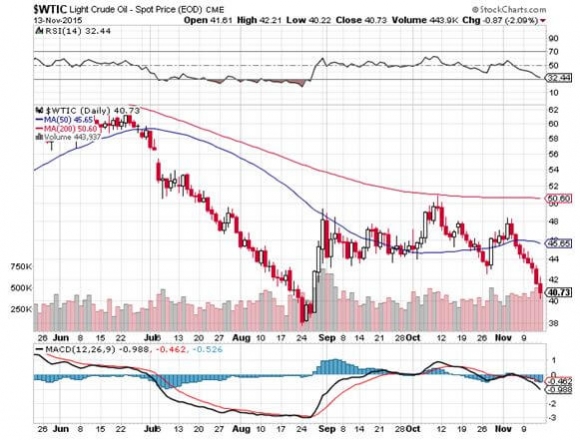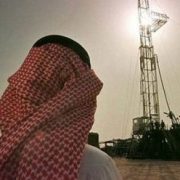Friends of mine at my former employer, the Financial Times, have met with the senior Saudi leadership in recent weeks and confirmed what I already knew.
The implications for your trading account and retirements funds are nothing less than far reaching.
The Kingdom?s long-term strategic goal is to create a global economic boom.
If they are successful, the value of all assets sensitive to the business cycle will explode in value. Those include stocks, commodities real estate, precious metals, and commodities. Only bonds, and other fixed income investments will suffer.
Saudi financial planners are betting that such a comeback is only one to two years off.
They will accomplish this by creating a world wide economic recovery that will eventually take the price of oil back up to at least $70-$80 a barrel, close to the price they need to maintain the world?s most generous social service system and balance their budget.
But to get there, they have to keep the price lower for longer.
So far, so good.
Since Saudi Arabia began its war for market share 18 months ago, $40 West Texas Intermediate is 63% off its 2014 high, and 74% down from the 2011 all time high.
At today?s prices, the global tax cut amounts to $2.24 trillion a year ($67/barrel saved X 92 million barrels/day global consumption X 365 days).
Saudi Arabia can easily add 1%-2% to global growth simply by keeping oil prices at the present level.
They can do this because they have oil reserves far beyond the understanding of all but a few industry experts.
I have traveled in the Middle East for 48 years.
I covered the neighborhood wars for The Economist magazine during the 1970?s.
When representing Morgan Stanley in the firm?s dealings with the Saudi royal family in the 1980?s, I paused to stick my finger in the crack in the Riyadh city gate left by a spear thrown by King Abdul Aziz al Saud when he captured the city in the 1920?s, creating modern Saudi Arabia.
The only mistake I made in my Texas fracking investments is that I sold out too soon in 2005, when natural gas traded from $2 a BTU to $5, and missed the spike to $17.
So let me tell you about the price of oil.
I?ll make it easy, and distill everything down to one single fact.
Saudi Arabia?s entire production of 11.5 million barrels a day, 14% of the world?s total, comes from 11 major fields.
THEY HAVE 70 OTHER SUCH FIELDS, which have yet to be surveyed and drilled. We know they are there because the geology is identical and the ultrasound data pans out.
So if Saudi Arabia wants to increase production to the point where every other producer in the world goes broke, THEY HAVE THE RESOURCES TO DO SO FOR ANOTHER CENTURY!
Saudi Arabia is not undergoing their current aggressive strategy without any pain. They are currently running an unprecedented 20% budget deficit (compared to America?s 12% in red ink).
For the first time, they have also emerged as massive borrowers in the international debt markets to bridge the funding gap.
But don?t expect the Saudis to change their posture one iota at the upcoming December 4 OPEC meeting in Vienna. They clearly see the present low price strategy as in their own best interest.
In my many dealings with the Saudis I have learned one thing.
They are playing the long game, the very long game. They obviously believe that global oil consumption will be greater over the next decade by keeping prices lower for longer, now.
And if every producer in the Bakken shale, the Marcellus shale, the Eagleford shale, and the Monterrey shale goes bankrupt first, that?s fine too.
It?s all about maximizing long-term market share.
Saudis have grown weary of being the free de facto put option for the world?s high cost producers, like American shale, Canadian tar sands, the Arctic, and offshore anywhere.
There has long been a belief that if oil prices fell below $100 for any period of time, the Saudis would simply throttle back their production and bump it back up.
Those days are long gone.
I have another theory about what?s going on.
If alternative energy sources maintain their current rate of expansion, oil will be rendered worthless by 2035.
For example, California has mandated that 50% of its energy will come from alternatives within 15 years. Many other states and countries will follow.
Therefore, it?s in the Kingdom?s interest to shift as much of their inventory before prices collapse to their production cost of $5/barrel.
If they can accomplish this faster than their oil producing, hostile competitors in the Middle East and Russia, so much the better.
You may say this all sounds like pie in the sky stuff.
But I happen to know that the Saudis are massive investors throughout the entire alternative energy venture capital spectrum, including solar, wind, ocean waves, geothermal, and even biodiesel (which I don?t believe in for two seconds).
They are NOT doing this because they need new energy sources for themselves.
The irony here is that if the Saudi plan is successful, it will add another 2-3 years to the Great American bull market that is now entering its sixth year.
The Saudis are also one of the biggest foreign Investors in US shares. It?s in their own self-interest to keep prices rising.
You have more in common with the Saudi royal family than you think.




